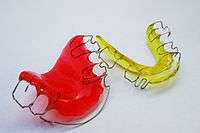Retainer (orthodontics)
Orthodontic retainers are custom-made devices, usually made of wires or clear plastic, that hold teeth in position after surgery or any method of realigning teeth. Once a phase of orthodontic treatment has been completed to straighten teeth, there remains a lifelong risk of relapse (a tendency for teeth to return to their original position) due to a number of factors: recoil of periodontal fibres, pressure from surrounding soft tissues, the occlusion and patient’s continued growth and development. By using retainers to hold the teeth in their new position for a length of time, the surrounding periodontal fibres are allowed to adapt to changes in the bone which can help minimize any changes to the final tooth position after the completion of orthodontic treatment.[1]


Removable retainers are only required to be worn part-time (at night).[2]
Hawley retainer
The best-known removable retainer is the Hawley retainer, which consists of a metal wire that typically surrounds the six anterior teeth and keeps them in place. Named for its inventor, Dr. Charles A. Hawley, the labial wire, or Hawley bow, incorporates 2 omega loops for adjustment. It is anchored in an acrylic baseplate that sits in the palate (roof of the mouth). The advantage of this type of retainer is that the metal wires can be adjusted to finish treatment and continue minor movement of the anterior teeth as needed.[3] It also benefits from being robust and rigid, easy to construct and allows prosthetic tooth/teeth to be added onto. The main disadvantages of this type of retainer is its inferior aesthetics, interference with speech, risk of fracture and inferior retention of lower incisors in comparison to vacuum-formed retainers.[1]
Recently, a more aesthetic version of the Hawley retainer has been developed. For this alternative, the front metal wire is replaced with a clear wire called the ASTICS. This retainer is intended to be adjustable similarly to the traditional Hawley retainer, which is not practical with vacuum-formed retainers.
Vacuum-formed retainers
Another common type of removable retainer is the vacuum formed retainer (VFR). This is a polypropylene or polyvinylchloride (PVC) material. This clear or transparent retainer fits over the entire arch of teeth or only from canine to canine (clip-on retainer) and is produced from a mold. The retainer is virtually invisible and clear when worn. Hence, it can provide aesthetics value to the patient. VFRs, if worn 24 hours per day, do not allow the upper and lower teeth to touch because plastic covers the chewing surfaces of the teeth. Some orthodontists feel that it is important for the top and bottom chewing surfaces to meet to allow for "favorable settling" to occur. Besides that, it is advisable to wear VFRs only at night, every night.[1] When eating is necessary, the retainer is removed to allow natural consumption and to avoid the crushing of the VFR. Patient should be informed never to drink, especially cariogenic or fizzy drinks, with VFR in situ as it will lead to substantial loss of tooth surface and dental caries (cavities). The retainer can behave like a reservoir, enclosing the incisal edges and cuspal tips with the cariogenic drink, leading to decalcification of teeth.[1] VFRs are less expensive, less visible, and easier to wear than Hawley retainers; however, for patients with disorders such as bruxism, VFRs are prone to rapid breakage and deterioration, especially if the material is PVC, a short chain molecule which breaks down far more quickly than polypropylene, a long chain molecule.[4]
Fixed retainers
A fixed retainer typically consists of a passive wire bonded to the tongue-side of the (usually, depending on the patient's bite, only lower) incisors. Unlike the previously-mentioned retainer types, fixed retainers cannot be removed by the patient. Some doctors prescribe fixed retainers regularly, especially where active orthodontic treatments have affected great changes in the bite and there is a high risk for reversal of these changes. While the device is usually required until a year after wisdom teeth have been extracted it is often kept in place for life. Fixed retainers may lead to tartar build-up or gingivitis due to the difficulty of flossing while wearing these retainers. As with dental braces, patients often must use floss threaders to pass dental floss through the small space between the retainer and the teeth.
Taking care of retainers
When the retainer is not being worn, it should always be kept safe in its container so it won’t be damaged or lost. Retainers are exposed to the same bacteria and plaque as the rest of a mouth, therefore they need to be cleaned after every meal. Retainers shouldn’t be placed in hot water and direct sunlight – they’ll easily warp. Retainers should always be removed before eating, because eating food with a retainer can damage it and will cause food to get stuck in hardware.[5]
See also
References
- Mitchell, Laura (2013-01-24). An Introduction to Orthodontics. OUP Oxford. ISBN 978-0-19-959471-9.
- Littlewood, Simon J; Millett, Declan T; Doubleday, Bridget; Bearn, David R; Worthington, Helen V (29 January 2016). "Retention procedures for stabilising tooth position after treatment with orthodontic braces". Cochrane Database of Systematic Reviews. doi:10.1002/14651858.CD002283.pub4.
- S., Lynn. "Part Six: After the Braces Come Off". Braces 101: a primer for adults new to braces. Retrieved 2008-08-26.
- Fida, Riora (15 June 2014). "Invisalign Leeds At Horsforth Smile Clinic". Horsforth Smile Clinic. Retrieved 2019-12-14.
- Burhenne, Mark (March 27, 2020). "The Best 4 Ways To Clean Your Retainer (No Harsh Chemicals Required)". Retrieved 2020-05-11.
| Wikimedia Commons has media related to Retainers. |